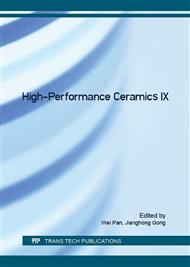p.113
p.119
p.124
p.129
p.134
p.138
p.143
p.148
p.153
Pore Forming Mechanism of Forsterite Insulation Materials Synthesized by Molten Salt Method
Abstract:
Abstract. The forsterite thermal insulation materials were synthesized by molten salt method with forsterite and NaCl-Na2CO3 salt, sintered at 1000°C, 1050 °C, 1100°C and 1150°C respectively. Studying complex pore structures is the key to understand the mechanism of pore-forming. The mechanism of the variation in the heterogeneous pore structure was analyzed based on differential thermal analysis, thermogravimetry, high-pressure mercury intrusion porosimetry and scanning electron microscope. The results show that the NaCl-Na2CO3 salt play the role of promoting sintering in liquid environment at high temperature as well as forming pore as placeholder. The mechanism of pore-forming contains three parts: the pores < 6.6 μm are mainly formed by sodium carbonate decomposition under high temperature and vapor pressure; the forming way of 6.6~66μm derives from carbonate decomposition and salt evaporate jointly; The salt stay in the slender and curved space shaped by the rearrangement of forsterite particles, forms the pore diameter of > 66 μm after salt dissolves in water.
Info:
Periodical:
Pages:
134-137
Citation:
Online since:
July 2016
Authors:
Keywords:
Price:
Сopyright:
© 2016 Trans Tech Publications Ltd. All Rights Reserved
Share:
Citation:


